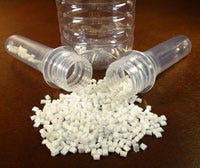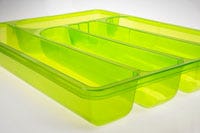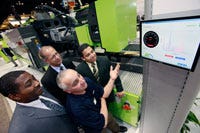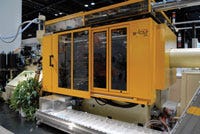As always, the big show in Chicago did its job, providing a venue for the latest, hottest technologies to get you back on track or put you one step ahead. Here are some of the highlights.—Rob Neilley, Kate Dixon, and Clare Goldsberry
July 30, 2009
As always, the big show in Chicago did its job, providing a venue for the latest, hottest technologies to get you back on track or put you one step ahead. Here are some of the highlights.—Rob Neilley, Kate Dixon, and Clare Goldsberry
Contrary to the concern of some in our industry that the global economic slowdown’s impact on the plastics sector could result in a scarcity of new technology at June’s NPE show in Chicago, there was plenty to check out and plenty of people checking. Here, then, are just a few highlights of the molding tech that was on display—a sampler of new resins, tooling, injection machinery, automation, and auxiliaries.
|
Next month, as part of our September issue, we will bring you the NPE Showcase, an overview of as much of the new mechanical, chemical, and electronic technologies as we could harvest during NPE’s five days. And we’ll look at the most up-to-date applications of both new and existing technology. It’s an impressive assortment. So stay tuned, fellow fans of molding technology.
MATERIALS
As expected, many additives and resins introduced at NPE carried the promise of befriending the environment, but some materials continued to impress with improved properties that yielded stronger, more beautiful parts.
Additive brings easy end of life
When it comes to eliminating plastic bottle waste, several biodegradable options recently have been developed, but each is affected by factors such as heat, light, moisture, stress, or by a short shelf life. However, a new additive offering normal physical properties and biodegradability called EcoPure from Bio-Tec Environmental (Albuquerque, NM) was used in Enso Bottles’ (Phoenix, AZ) PET water bottles handed out at the show. At a ratio of less than 1%, EcoPure allows plastic to break down, but only in a microbe-rich environment, such as landfills and compost facilities.
When the bottle’s indefinite shelf life comes to an end by exposure to microbes, the polymer chains are broken down into organic monomers by expanding the molecular structure of the plastic, scissoring the polymer chain, and adding in nutrients that attract the microbes to colonize in and around the plastic. Acids secreted by the microbes further break down the molecules, yet the only by-products created are CO2, soil-enriching humus, and methane that can be used as fuel. And unlike PLA, photo-degradable, and oxo-degradable bottles that can’t break down in anaerobic environments (meaning lacking oxygen), the EcoPure bottles biodegrade in one to five years, even without the presence of light, heat, or moisture.
There is no need to change the manufacturing process since EcoPure is added in like any other additive. Also, physical properties remain the same. In addition to PET, EcoPure can be added to PE, PP, PS, and PVC, as proven in third-party testing (ASTM D5511, D5338, and D5988).
In July, PET bottle manufacturer GoodPac Plastics, a division of Goodwin Enterprises (Atlanta, GA), announced that it would offer Enso biodegradable bottles. “Over the years, we’ve taken special pride in producing high-quality products. Now, by adding our environmentally friendly Enso bottle, not only do we continue to offer excellent-quality products and superior service, we are doing our part to help to encourage bottle recycling and are effectively eliminating plastic bottle waste,” says Jim Goodwin, president of GoodPac Plastics.
Clarifier reduces PP haze by half
Polypropylene has seen wider use in this cost-cutting economy, but a lack of clarity has restricted its use in certain applications. A new clarifier from Milliken Chemical (Spartanburg, SC) is aimed at solving that problem by providing a 50% haze reduction compared to the current industry standard, delivering clarity approaching that of polycarbonate without the associated expense or other drawbacks. Millad NX8000 is said to offer excellent rigidity, strength, and heat and chemical resistance while remaining free of BPA that is used in PC. “Our Millad technology supports sustainability by broadening the potential applications of PP, which is compatible with established recycling systems and also requires less resin due to lower density,” says Jean Hall, business manager for Milliken.
The clarifier was used by Italian manufacturer Guzzini for a PP injection molded utensil tray, which was an entry in the NPE International Design Competition. The tray was originally made with styrene acrylonitrile (SAN) but Guzzini redesigned the product using clarified PP to reduce cost and boost impact resistance. The lower-density PP requires less resin than other clear polymers, and is more easily recycled in the existing waste management infrastructure, further enhancing the product’s sustainability.
INJECTION MOLDING MACHINES
Continuing a trend we’ve seen for almost a decade now, the new molding machines at NPE2009 were more often than not specialized, matched to a particular product, material, or market—and highly automated. Systems for liquid silicone rubber (LSR) molding were much in evidence, as were multimaterial machines. But there was one theme that we found in virtually every machine maker’s booth: Energy—saving or reducing its consumption—was on everyone’s mind. To be sure, that theme was not confined to molding machinery, but at NPE, an all-electric or hybrid injection system touting its energy cost savings was never far away.
Servo-precision inmold labeling, assembly
Arburg’s (Newington, CT) largest electric molding machine, the Allrounder 720 A, was on view for the first time in the U.S., popping out four packaging lids every 5.6 seconds. Nearby, a 165-ton electric Allrounder 520 A was on show, and you could say showing off—unless you routinely do inmold labeling and inmold assembly of a six-part toy race car.
It looked like the same car we saw being molded at NPE2006, but Wade Clark of tool supplier Electroform (Rockford, IL) said a number of improvements had been made to the twin-cube rotating stack mold and IML feeding system since then. And they must have been good ones to cut cycle time from 23 to 11 seconds for labeling, molding, and assembling it all.
An Arburg Multilift V (vertical) robot handled label insertion and removal of the fully assembled car. The Allrounder A’s main axes are servodriven, enabling both high precision and fast, simultaneous movements that support shorter cycle times. The car-molding machine also featured an optional integrated small-accumulator hydraulic system to run the auxiliary axes. And lest we forget, the machine carries Arburg’s “e” mark, signaling energy efficiency.
At one point, a label malfunction caused several labels to be put into the mold, which caused some damage to the mold, Clark said. “I took the cavity out, ran it over to the South Hall to my laser welder, [Lasertechnology Inc.; Elk Grove Village, IL], which was exhibiting over there,” he explains. “They had their microwelder so were able to repair the damage. We put the mold back together and were back in business quickly. It’s sure nice to have your vendors at the show with you!”
Precise motion = lighter, yet stiffer parts
For NPE2009, machine/automation system supplier Engel (York, PA) had a one-word slogan: electrified. Accordingly, the company was showing many energy-saving opportunities. For example, Engel’s brand-new duo pico two-platen machine is designed to be energy frugal. It reduces consumption by 45-60%, says the company, by using a servo hydraulic system and electric screw drive, among the other technology packed into its small footprint (<24 ft/550 ton).
Engel also presented new integrated energy calculator software for the latest version of its CC200 machine control (hydraulic or electric). Enter the job’s shot weight on the control screen and it calculates the energy needed to mold the part using settings such as clamp motion, cooling, and ejection. Using the on-screen dashboard, an operator can adjust all motion parameters individually to achieve maximum energy efficiency without disturbing overall cycle time or throughput.
Engel attracted a lot of attention with its MuCell core back expansion molding, which combines Engel’s core back molding machine technology with the MuCell foaming process from Trexel Inc. (Woburn, MA). During NPE, Engel molded a prototype auto interior door panel on a 1000-ton duo (500- to 6000-ton range) machine. The core back technology means that the resin with the Trexel foaming agent already added is injected into the closed mold. After a predetermined time, the mold opens slightly and the internal pressure of the foam fills out the newly added cavity space.
David Bernstein, president of Trexel, says this application exemplifies a new stage in MuCell technology. The first stage, he says, has been about saving weight and material. In the second stage, products are being design-optimized to take advantage of MuCell. Wall thicknesses can vary and the normal rib/wall thickness ratios no longer apply. The internal pressure means that packing pressure comes from within the material.
Weight savings with core back expansion molding can be 50% or more of a part of the same dimensions without the foam, and the added thickness also yields a stiffer part. Steve Braig, president of Engel North America, says you need precise machine technology with the MuCell process to succeed in core back molding. The Engel duo, he continues, is the only two-platen molding machine whose moving platen has no contact with the tiebars. This eliminates friction, and allows more precise control of speed and movement. Duos also feature a platen parallelism control that allows the four corners of the mold to be positioned individually, increasing the ability to achieve dimensional accuracy.
Ultrafast closure system stopped traffic cold
Though Husky (Bolton, ON) fielded numerous examples of its technology in its spacious NPE booth—enhanced hot runner lines, new production monitoring software, three complete molding systems, and more—its new HyCap beverage closure molding system was drawing in large groups of show-goers all week. Its high-speed output of water bottle closures seemed virtually continuous. That should not be surprising when a 72-cavity mold is running at sub-3-second cycles.
Since Husky molding machines all tend to look like, well, Husky machines, it’s easy to assume the company had tweaked one of its existing speedy systems. Not true, says Mark Fitzpatrick, who manages Husky’s closure business. Virtually every aspect of the HyCap, available from 248-500 tons, is optimized for closure production adhering to Husky’s mantra: It all starts with the part.
Fitzpatrick was happy to be specific about the refinements, starting with faster clamp cycles and reduced cooling time. The Altanium hot runner control has been tightly integrated with Husky’s Polaris machine operating control. A number of modifications have been made to the machine and hot runner to attain tighter tolerances, better melt control, and minimal plate deflection, and to handle the differing needs of various closure polymers. The screw is purpose-designed, power has been increased, hydraulics are made for two to three times faster decompression, and injection speed has been increased.
As a result of this system design, says Husky, the HyCap is a good fit for making the increasingly popular shorter, lighter-weight caps—for example, the PCO 1881 neck finish. The 0.98g cap and <3-second cycles compare favorably with industry standards of 1.6g caps on 3.5- to 4-second cycles.
The HyCap 300 (tons) RS65/60 system working at NPE was making caps weighing less than 1g in an HDPE grade from Dow in a 72-cavity mold made by Swiss moldmaker Corvaglia. Husky, says Fitzpatrick, works with a number of moldmakers for these systems. Resin loading was via a Piovan feeding system; molded closures free-dropped from the mold easily thanks to Husky matching the ejection and platen speeds; part handling used an IMD Vista AllinOne with part cooling, orientation, vision inspection, and boxing; and a Plastic Systems DSH1000 mold dehumidification system kept the mold area dry.
Machine nozzles for easier processing
Melt Design Inc. (MDi; St. Charles, IL) introduced an internally heated molding machine nozzle at NPE2009 for the North American market. "There's been a lot of interest in it since we've made this available," says Dick Genc, director of sales. "It makes startup and production easier, and easier to run hard-to-process materials such as PVC and high-temperature materials."
TOOLING
The striking thing about moldmaking at NPE was the number of molds running in various molding presses around the show floor. It seemed to be a real partnership between molding machinery suppliers, auxiliary equipment manufacturers, and moldmakers. What better way for all parties to showcase their products, expertise, and technology than to have a high-tech mold running in a high-tech manufacturing cell? Here are a few examples.
Automation ratchets up IML
CBW Automation (Fort Collins, CO) showcased its new inmold labeling system featuring inline cutting of the labels. Mold manufacturer StackTeck Systems Ltd. (Brampton, ON) provided the food container mold running in CBW’s stand. The system on display cut the roll-fed labels to the exact size with cutting accuracy to within ±0.005 inch. The labels were then picked up and placed on mandrels that physically inserted the labels into the mold. The cut-in-place inline process eliminates a step in the supply chain (precutting labels) and eliminates the magazines required to hold the stacked labels near the molding machines, thereby reducing the cost of labor to fill them.
The system also reduces scrap, and is versatile in that the roller diecutting tool can be changed out to a different cut on a different label in 10 minutes. After that it’s much like a traditional changeover in which you change out the mandrel and the pick-and-place for the label.
“We’ve averaged a 30% label cost reduction over the past three years with this system, and that’s a big deal,” says David Carson, president of CBW. “Additionally, the material itself is thinner—we used a label that was 45 µm—and it requires no antistat. The whole purpose of antistat is to make magazines work efficiently, so without the magazines we can actually put more static in the plastic, and the label will hold better in the mold. Also, there is a labor savings in that a roll can run for 6-8 hours of production time without the labor involved in having to refill magazines.”
LSR molding ever more widespread
When Rick Finnie, president of M.R. Mold & Engineering Corp. (Brea, CA), signed up for a booth at NPE, he knew he would also have a mold running at one of the machinery manufacturer’s stands. Finnie specializes in design, build, and process tryouts of liquid silicone rubber (LSR) molds. However, Finnie got calls from a total of three injection molding machinery makers to run LSR molds in their LSR machinery.
So the company ran its molds in Negri Bossi, Toshiba, and Boy machines, says Finnie, to enable those companies to showcase their LSR processing equipment and capabilities. “All these companies are trying to show their various capabilities, primarily because LSR has become so popular,” says Finnie. “And in this market, trying to find a niche that’s actually growing is tough.”
Finnie said he’s always amazed that, as many years as LSR has been around, “it’s still so new to so many people.” Finnie has a Technical Center at his Brea facility, in which he runs three LSR molding machines and performs R&D for new product and process development as well as mold sampling.
Creativity is what keeps M.R. Mold on the cutting edge. Over the past few years Finnie has developed and commercialized LSR baking cups for cupcakes. They come in three sizes and are wildly popular, particularly as NPE show giveaways. Finnie’s newest product is his Cold Runner System for LSR, which he has just started commercializing. The system comes with mold base plates by Royalloy; the water jackets are titanium, and nozzles are 420-SS. Nozzle tips are Vanadis powdered metal, which have a long life—up to 250,000 cycles compared to 50,000 from typical S-7 tips.
AUXILIARIES
Granulator spots metal
Increasing material costs and inclusion of recycled content in molded products makes effective grinding of sprues and rejects more important than ever. But a small metal fragment can lead to big damage to a granulator, so a patented Integral Metal Detection (IMD) feature on Rapid Granulator’s (Rockford, IL) new RG-Series screenless granulators stops the machine before damage can happen. When ferrous metals are detected, the isolated plates give a signal to switch off the machine immediately, preventing a piece of metal from breaking off a tooth, which can lead to multiple broken teeth in a closed system.
The family of eight beside-the-press basic models ranges from the RG-1 for small parts and sprues to the RG-4 Twin, which can granulate items as large as bumpers and dashboards. These slow-speed screenless granulators also have a reversible motor function (REV), which enables the machine to determine if resistance to the cutting blade is too high, in which case it reverses the rotor to reposition the part for cutting from a different angle. To help reduce wear, noise, and damage to the gear box and motor, the granulators are also equipped with soft coupling to absorb stresses and vibration.—[email protected]
About the Author(s)
You May Also Like










